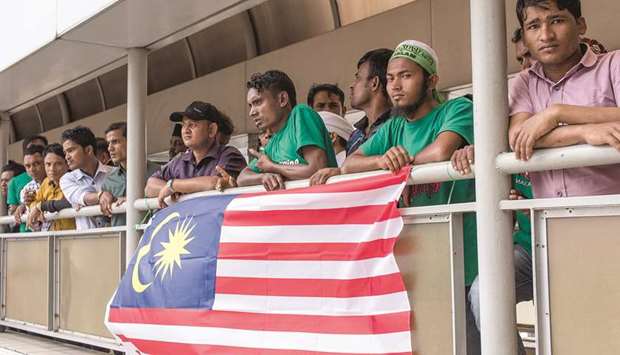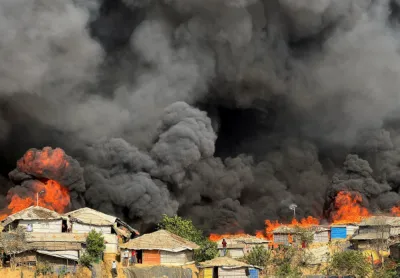“There are probably thousands” more stuck in a no-man’s land at the Bangladeshi border, said Chris Lom, the organisation’s Asia-Pacific spokesman. Ahead, border guards block their escape from the state. Behind, their hometowns are engulfed in flames, reportedly burned by Myanmar government forces.
Many fear for their lives. Most are women and children, and some are wounded, the UN refugee agency has reported. At least two women and two children drowned while trying to escape to Bangladesh by boat.
Those Rohingya who have escaped say that government forces set fire to their villages. Satellite data corroborates their testimony, showing “widespread fires” in Rohingya areas, Human Rights Watch said in a statement. Videos online show the refugees sobbing as gunfire crackles in the distance.
“The situation is very terrifying, houses are burning, all the people ran away from their homes, parents and children were divided, some were lost, some are dead,” Abdullah, 25, a Rohingya from Rakhine’s Buthidaung region who gave only one name, told Reuters.
What’s happening, and how did the situation get so bad? Here’s what you need to know:
How did this happen?
It began in northern Rakhine state on Aug. 25, when a group of Rohingya insurgents calling themselves the Arakan Rohingya Salvation Army – many wielding machetes, swords and knives – staged a co-ordinated pre-dawn raid on 30 police posts and an army base. They killed 12 security officers, and in the ensuing conflict, security forces killed 77 of them, according to the Myanmar government.
Government forces, analysts suspect, responded with a scorched earth campaign, torching homes and shooting civilians. Thousands of Rohingya quickly fled to the border. On Wednesday, Bangladesh further tightened border controls, to keep more Rohingya from getting through.
Many of Rakhine’s Buddhists have also fled, most to the state’s Buddhist-majority capital, Sittwe.
Who are the Rohingya?
The Rohingya are often called the world’s largest stateless minority. About 1.1 million of them live in Myanmar, most of them in Rakhine state. The Myanmar government denies the Rohingya citizenship and voting rights, claiming they’re illegal immigrants from Bangladesh. Bangladeshi authorities say they’re Burmese. (Myanmar was formerly known as Burma.)
Since a wave of Buddhist-Muslim violence in 2012, the Myanmar government has virtually held them prisoner in their own country, confined to squalid ghettos and watched over by armed guards.
Analysts say the discrimination has fuelled a rise in extremism. In October 2016, the Arakan Rohingya Salvation Army launched its first-ever attack, targeting three border posts and killing nine policemen. Security forces, according to a UN investigation, retaliated by burning villagers alive in their houses, or shooting them as they fled. They gang-raped women and hurled children into fires. They killed more than 1,000 Rohingya, according to best estimates.
Approximately 85,000 Rohingya fled to Bangladesh, joining more than 200,000 others in squalid refugee camps, where they remain.
The United Nations concluded that the army’s abuses likely amounted to crimes against humanity, charges the government denies.
Analysts say conditions in Rakhine state have caused a vicious cycle of violence. They “create an environment where (the insurgent group) can increase its legitimacy and recruiting base among local communities and more easily intimidate and kill Rohingya who disagree with it and lack any real protection from the state,” the International Crisis Group said in a statement recently.
What is the Myanmar government doing about it?
Myanmar officials have presented the violence in Myanmar as an attack by “extremist terrorists” influenced by foreign forces, and have defended the military’s behaviour.
The country’s elected leader, Aung San Suu Kyi, called last week’s raids “a calculated attempt to undermine the efforts of those seeking to build peace and harmony in Rakhine state.” She did not address allegations of military misconduct.
Rights groups have condemned the response. Many once considered Suu Kyi, a Nobel Peace Prize laureate, an icon of democracy. The country’s brutal military junta had confined her to house arrest for 15 years before watershed elections in 2015 ushered her into power.
In a Facebook post Sunday, her office suggested that international aid workers had been abetting the insurgents. It posted pictures of World Food Program biscuits that it said were found “at the camp where terrorists sheltered.”
On Tuesday, the United Nations said it had suspended aid operations in the town of Maungdaw in northern Rakhine state, citing safety concerns.
Suu Kyi’s remarks were “irresponsible and only serve to increase fears and the potential for further violence,” Zeid Ra’ad al-Hussein, the UN High Commissioner for Human Rights, said in a statement. He added that “decades of persistent and systematic human rights violations” have contributed to the rise in extremism in the area.
Suu Kyi “frankly is really turning out to be someone who has no real abiding interests in human rights,” said Phil Robertson, deputy director of the Asia division for Human Rights Watch. “It’s quite clear in the case of the Rohingya, she’s been toeing a strong Burmese nationalist line, that these people don’t belong here, and frankly, they’re terrorists.
“She’s a part of the problem, to be quite clear,” he said.
What’s next?
Eleven days ago, hours before the violence broke out, the official Advisory Commission on Rakhine State – led by former UN Secretary-General Kofi Annan – released a report warning that the violence in Rakhine could spiral out of control. It proposed giving the Rohingya improved rights, including freedom of movement and political participation.
Yet analysts said that the current violence – and the government’s response – dampen hopes that officials will follow its counsel.
Robertson of Human Rights Watch said that many of the refugees will likely settle in unofficial camps in Bangladesh.
“These people have no status – they’ll get some support from the UN and other NGOs, but very limited amounts,” he said. “And once the winds and waves slow down in the Andaman Sea, which we’ll see in October, we’re gonna see another boat people crisis.”
In May, 2015, thousands of Rohingya attempted to flee Myanmar via the Andaman Sea on overcrowded boats, but their smugglers abandoned them, leaving them adrift without food and water. Many died of starvation and disease.
The status of an estimated 40,000 Rohingya refugees in India is also uncertain. This month, the Indian government instructed authorities nationwide to deport illegal migrants from Rakhine state, saying they were a “burden on the limited resources of the country” and posed “security challenges.” – TNS



